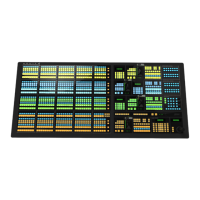• Audio is embedded in the ancillary data of the video
stream that the Global-Store channel is included in.
• The number of Global-Store Audio channels is the
same as the Global-Store video channels.
• Audio is loaded into the corresponding Global-Store
Audio channel as the Global-Store video channel.
For example, if you load a clip with audio in video
channel 2 the audio is loaded into audio channel 2.
• Loading a clip with audio into a Global-Store Audio
channel only loads the audio and will not load the
corresponding video.
• An audio le does not need to be of the same length
as the animation it is associated with.
• A Global-Store channel can be loaded with audio
only.
• An ME-Store channel cannot load audio.
• Audio is played the same way an animation is played.
• The length of an animation is set my the video rate
the switcher is operating in. Audio is xed at 48kHz.
If your audio and video is synched at a particular
video rate, playing the media at a different rate will
result in the audio and video being out of synch.
• Audio only looping is independent of video looping.
• Video with audio will only auto start when it is taken
on-air, and not when it is loaded or the properties are
changed (as with video only media).
• Audio always plays out at 1x speed, even is the video
is playing faster or slower.
To Associate an Audio File with Video
You can associate an audio le with a video le. When
the video le is loaded, the associated audio le is also
loaded.
1. Press the source button for the media-store channel,
or press Press HOME > More > Effects > Media
Store.
2. Use the Location knob to select GS Video.
3. Use the Channel knob to select Channel 1.
Tip: You can use any channel for the association, as long
as the video and audio are both loaded into the same
channel.
4. Press Select/Manage and load the video le that
you want to associate an audio le to.
5. Use the Location knob to select GS Audio.
6. Use the Channel knob to select Channel 1 (the
same channel as you loaded the video in).
7. Press Select/Manage and load the audio le that
you want to associate to the video le.
8. Press More.
9. Press Associate Audio to associate the audio le
with the video le.
Tip: Press Remove Audio to remove an association that
has already been set up.
Transferring Media Files
Media les are transferred to and from the switcher using
the FTP protocol. Once transferred onto the hard drive
of the switcher, the les can be loaded into the
Global-Store or ME-Store of the switcher.
Important: Do not use FTP to move media files
around on the switcher. If you move a file with FTP
the associated on-air properties for that media file will
be lost.
To Set Up FTP
Any FTP client can be used to connect to the frame for
transferring les.
The default IP address for the frame is 192.168.1.1 and
the default user name and password are user and
password.
To Transfer Media Files From a USB
If you do not want to create a network connection to the
switcher, you can copy stills using a USB drive. The
stills must be the only les on the USB drive, and be
located at the root directory.
Note: The USB drive that the stills you want to transfer are
stored on must be formatted as FAT32. If the USB drive is
formatted at NTFS, the transfer will not work.
1. Copy the media les that you want to transfer to the
switcher to the root directory of a blank USB drive.
2. Insert the USB drive into the USB port on the top
of the control panel.
3. Press HOME > More > Effects > Still Store >
Select/Manage.
4. Press Copy From USB. All valid media les on
the USB drive are copied to the /USB folder on the
switcher.
Media-Store Capture
Still images, animations and audio can be created from
any video signals available on the main preview or aux
bus output. Captured media items can be of the entire
image, or of cropped sections of the image. When
capturing a media item, you can preview and use what
was captured before saving it do disk. You must save the
captured media item to disk before performing another
capture, or loading another media item into that
76 • Media-Store — Acuity Operation Manual (v9.2)

